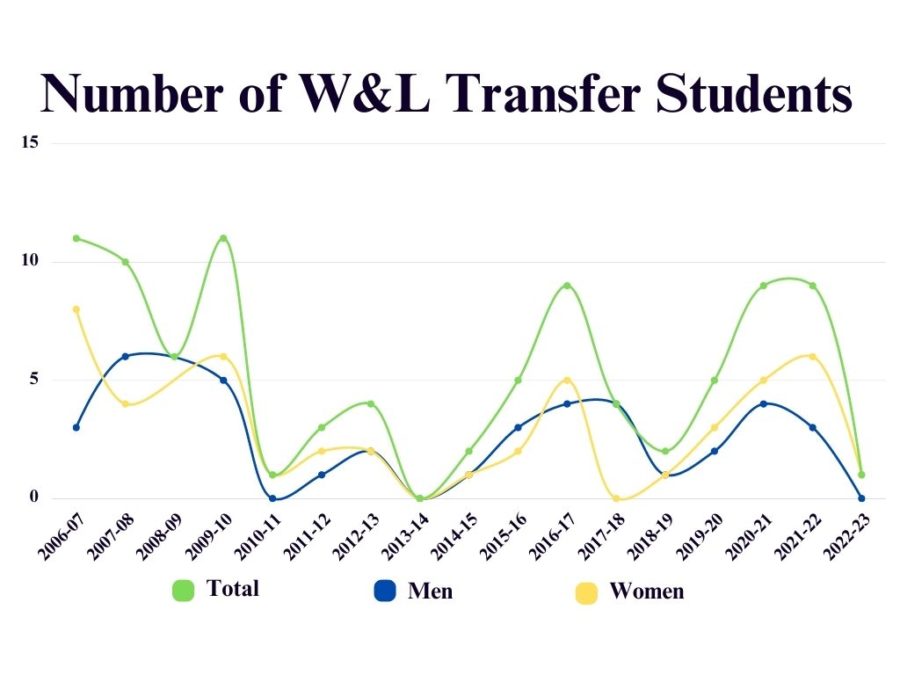Female transfer students face social barriers in sorority recruitment
Rush rules leave older students feeling isolated, especially those without campus connections
Female students who transfer into W&L with a sorority affiliation from their previousuniversity face smoother transitions into Greek life on campus. Photo by Bri Hatch, ’23
May 8, 2023
Eugénie Rovegno, ’24, remembers sitting alone in a theme house while all her friends were at a sorority house watching a movie. She wasn’t allowed to join because of Panhellenic recruitment rules.
Rovegno transferred to Washington and Lee as a sophomore. She easily found community as a member of the lacrosse team. But she began to wonder, outside of lacrosse, where she fit in.
“I was socially uncomfortable for a while, but I experienced a lot of personal growth even though, in the moment, it kind of sucked and was difficult,” Rovegno said.
The number of female transfer students at Washington and Lee University has tripled in the past decade, according to Washington and Lee’s Common Data Set. At a small university with around 75 percent of women affiliated with sororities, some say it can be difficult for transfer students to find a genuine community during their first semester on campus.
Washington and Lee holds formal sorority recruitment in January each year. The fall semester is designated as informal recruitment, where active members of a sorority take potential new members on “rush dates” to see if they would fit well in their organization. This period comes with various rules, such as the ratio rule, which says there cannot be more than two active sorority members present with one potential new member.
“Certain things, like the ratio rule, were really frustrating as a sophomore,” said Mary Margaret Greer, ’24. “It made me feel really closed off and separated from my grade.”
Greer is one of six female students who transferred to Washington and Lee for the 2021-2022 academic year, according to W&L’s Common Data Set. In the 2011-2012 academic year, there were only two female transfer students.
Female transfer students said the informal recruitment process can be strange since they are being rushed by sorority members their age, while normally sorority members rush first-year students.
“I really hated the informal process,” Greer said. “It’s not really tailored to people who aren’t freshmen.”
Greer transferred from Elon University where she was not part of a Greek organization. During her first year at Washington and Lee, she lived in theme housing off-campus with a couple of other transfer students.
“I didn’t feel much of a community outside of my theme house,” Greer said. “I felt really alone, and, although I found relationships that were authentic with activities, I always felt like I was on trial or being interviewed. It took me until after Bid Day to realize they actually wanted to be my friend and I wasn’t just a quota for a rush date.
Greer participated in the recruitment process and joined Kappa Alpha Theta in January of her sophomore year. She said she found her best friends in Theta, and they push her to do things she never thought she could accomplish, such as being a Fancy Dress chair.
Rovegno, who’s also a junior, had a similar experience to Greer. They both are grateful that they came into Washington and Lee not previously affiliated with a sorority, even though it did make their first semester very difficult.
“I think starting fresh was a little bit difficult, but it definitely pushed me outside of my comfort zone and made me more confident,” Rovegno said.
Rovegno attended Bowdoin College for her first year of college, took a gap year, and then began at Washington and Lee as a sophomore in 2021. She joined Kappa Kappa Gamma, known as Kappa, in January of her sophomore year.
Rovegno is a part of the women’s lacrosse team and her older brother attended Washington and Lee, so she had connections and people looking out for her throughout recruitment.
Greer agreed that not having connections would make the rush process for a transfer student much harder.
“Honestly I don’t think I would’ve had the rush dates I had if it weren’t for the people living in my house or the people my neighbors knew on campus,” Greer said. “Honestly, that’s kind of what sucks about it, especially for a transfer that comes in and doesn’t know anybody.”

While the university is great at connecting transfer students to each other, Greer said, there is no list of transfer students given to sororities, so there is no way for active members to specifically look out for transfers during the rush process.
Dean Kyle McCoil, the primary resource for transfer students, and Leah Beard, Panhellenic campus advisor, did not comment in time for publication.
Without those resources, Greer said, she had very little community her first semester since all she was involved in was Fancy Dress. She became friends with those living in her off-campus house, but she didn’t have the benefit of older siblings or a sports team, as Rovegno did.
Even with those connections,Rovegno struggled in her first semester.
“Not having to follow all of the rush rules that the first-years have to follow would have made the transferring transition a lot easier,” Rovegno said.
Students who transferred to Washington and Lee with a sorority affiliation from their former college say the process is much easier.
Parker Sparks, ’25, transferred from Wake Forest University, where she was a part of the Alpha Delta Pi sorority. She joined the sorority chapter at Washington and Lee during her first semester on campus, but disaffiliated during the winter due to financial reasons.
Sparks said she has been able to find community outside of Greek life through different campus organizations, such as Reformed University Fellowship, a campus ministry group.
Stella Rose Graham, ’23, smoothly transitioned into Greek life during her sophomore year on campus. She transferred from Southern Methodist University with a Kappa Kappa Gamma membership — and gained access to the same organization here after a sorority-wide vote ruled in her favor.
While there are some differences, Graham said the chapters at the two universities are generally similar. Rather than waiting until January to rush like other transfer students, she was grateful to join Kappa during her first semester.
“I was very lucky to be able to have an immediate group of friends,” Graham said. “Although they didn’t have to be friends with me, I feel like they felt obligated and were really welcoming. It was like 26 girls that were really open to getting to know me.”
Graham said she goes out of her way to recruit transfer students to her sorority. Sorority members that weren’t transfer students themselves often don’t think about the challenges, Graham said.
Rovegno agreed.
“I could definitely see how transfer students can be forgotten,” she said.




